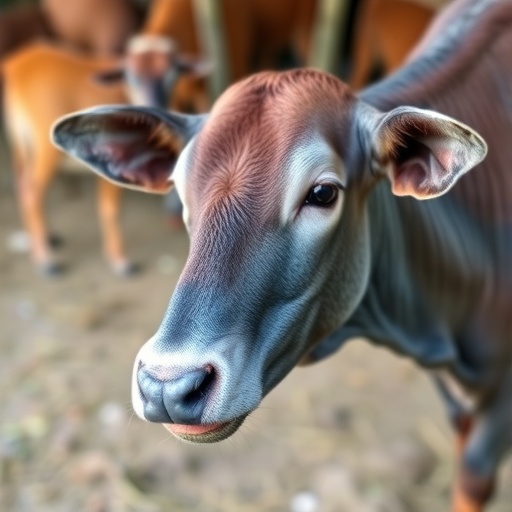In recent years, the bluetongue virus (BTV) has gained significant attention as a major pathogen affecting small ruminants across various regions, particularly in South Asia, including Bangladesh. The emergence of new strains and the complexities associated with its epidemiology and control measures have necessitated comprehensive reviews to better understand this virus. In an illuminating study by Haque et al., insightful information regarding BTV has been compiled, focusing on its prevalence, symptoms, diagnostic techniques, and potential control strategies that can be employed in the affected regions.
Bluetongue virus is primarily transmitted by Culicoides midges, which present a formidable challenge to livestock health and productivity. The disease is characterized by fever, swelling, and lesions, leading to substantial morbidity and mortality rates among infected ruminants. The ongoing climate changes and alterations in livestock management practices in Bangladesh and South Asia have contributed to the increased prevalence of this viral infection, further exacerbating the challenges faced by farmers and veterinarians in the region.
One of the key issues highlighted in the review is the virus’s dynamic genetic diversity, which poses significant obstacles to the development of effective vaccines. Various BTV serotypes can co-circulate, and the mutations within the virus’s genome can result in altered virulence and pathogenicity. This phenomenon underscores the importance of continuous surveillance and genomic studies, as recognizing emerging strains can facilitate the timely development of targeted control measures and vaccines.
Early diagnosis of bluetongue is another critical aspect addressed by Haque and colleagues. The symptoms often resemble those of other infectious diseases, making differential diagnosis challenging. Advances in molecular diagnostic techniques, such as RT-PCR and serological assays, have significantly improved the speed and accuracy of detecting BTV. Such rapid diagnostic capabilities are vital for implementing timely interventions to reduce the spread of the virus within flocks.
Control strategies for bluetongue virus are multifaceted and require a comprehensive understanding of both the viral biology and the environmental factors influencing its transmission. Vaccination remains one of the most effective ways to mitigate the impact of BTV, but the effectiveness of existing vaccines can vary depending on the circulating strains. Consequently, the review emphasizes the need for ongoing research to evaluate the current vaccines and explore innovative approaches, such as recombinant vaccines or those based on viral vectors.
The relationship between environmental conditions and the epidemiology of bluetongue virus cannot be overlooked. Changes in temperature and rainfall patterns can influence the breeding and feeding behaviors of Culicoides midges, thereby affecting the transmission dynamics of the virus. As climate change continues to alter weather patterns, understanding these relationships becomes increasingly important for predicting and mitigating outbreaks in small ruminant populations.
In addition to environmental factors, socio-economic considerations play a crucial role in managing BTV outbreaks. Farmers in South Asia often operate within resource-limited settings, making it essential to develop affordable and accessible control measures. Effective communication and educational programs that inform livestock owners about the risks of BTV and the benefits of vaccination, biosecurity practices, and vector control can empower them to take proactive steps against the disease.
The review also touches upon the importance of a One Health approach in tackling bluetongue virus, which acknowledges the interconnectedness of human, animal, and environmental health. Collaborative efforts between veterinarians, public health officials, and environmental scientists can lead to more comprehensive strategies that address not only bluetongue but also other zoonotic diseases that may emerge in the region due to changing ecological landscapes.
As we look to the future, it is clear that research into bluetongue virus must be prioritized to safeguard small ruminant health in Bangladesh and beyond. Continuous funding for research initiatives, combined with international collaboration, will be imperative for enhancing our understanding of BTV and its broader implications for livestock health and rural economies.
In conclusion, the comprehensive review by Haque et al. provides valuable insights into the complexities surrounding bluetongue virus in small ruminants. By addressing the epidemiology, diagnostic challenges, and potential control strategies, this work paves the way for future research and the development of effective interventions. The urgent call for action in the face of emerging viral threats emphasizes the need to approach animal health holistically in order to ensure the sustainability of livestock sectors in vulnerable regions.
In the context of small ruminants affected by bluetongue virus, the synthesis of knowledge from these ongoing studies, along with concerted efforts from stakeholders across sectors, will usher in more resilient farming systems capable of withstanding the challenges posed by infectious diseases. As we harness this knowledge and work collaboratively, the prospects of improved animal health and productivity in South Asia look increasingly promising.
Subject of Research: Bluetongue Virus in Small Ruminants
Article Title: Comprehensive review of emerging insights into bluetongue virus in small ruminants with emphasis on epidemiology, diagnosis, and control in Bangladesh and South Asia.
Article References:
Haque, M.N., Rahman, M.H., Naher, L. et al. Comprehensive review of emerging insights into bluetongue virus in small ruminants with emphasis on epidemiology, diagnosis, and control in Bangladesh and South Asia.
Discov Anim 2, 76 (2025). https://doi.org/10.1007/s44338-025-00124-4
Image Credits: AI Generated
DOI: 10.1007/s44338-025-00124-4
Keywords: Bluetongue Virus, Small Ruminants, Epidemiology, Diagnosis, Control Strategies, Bangladesh, Climate Change, One Health, Molecular Techniques, Vaccination.
Tags: bluetongue symptoms and diagnosisBluetongue virus South AsiaBTV prevalence in BangladeshBTV vaccine development obstaclesclimate change effects on livestockcontrol strategies for bluetongueCulicoides midges transmissionemerging strains of bluetongue viruslivestock health and productivitysmall ruminants disease managementveterinary challenges in South Asiaviral genetic diversity challenges





